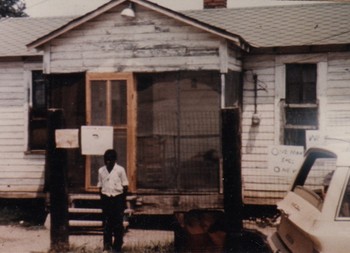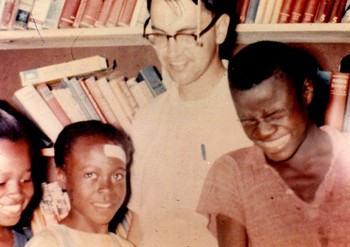Although it has been 50 years since I participated in Mississippi’s Freedom Summer, the memories of my brief time among incredibly brave people are fresh as ever. They provide a very different picture of the events in the summer of 1964 from those depicted in the movie Mississippi Burning.
I am writing partly to offset the view fostered by the movie that during that summer all Mississippi blacks cowered in fear after the murder of the three civil rights workers and that it took the valiant efforts of white FBI agents to rescue the hapless blacks from the KKK reign of terror.
A clergy friend and I did find many blacks whose fear prevented them from participating in Freedom Summer, but we also came into contact with hundreds who overcame that fear and displayed a courage — and a love — that we had never seen before or since.
I should add that what follows is not intended to demonize the white segregationist: I myself was raised as a racist familiar with the “n” word. Were it not for a series of events in which I can now see the grace of God, I could have been one of those who condemned any talk of equal rights.
Methodist pastor Roger Smith and I were answered the call from the National Council of Churches (NCC) to join the hundreds of college students and others in a massive voter education program during the summer of 1964.
Leaders of national civil rights groups united their efforts, leading to the formation of the Council of Federated Organizations (COFO). The groups that joined to form COFO were the Student Nonviolent Coordinating Committee (SNCC), the Southern Christian Leadership Council (SCLC), the National Association for the Advancement for Colored People (NAACP) and the Congress on Racial Equality (CORE).
It was believed that the only way to get the attention of the national press would be if the victims of beatings and arrests were sons and daughters of influential Northerners. (The new PBS documentary Freedom Summer points out that SNCC leaders opposed this idea at first but came around to accepting the premise.) The NCC appealed to clergy to volunteer their vacation time. College students, lawyers, medical personnel and teachers also volunteered.
And so Roger Smith and I found ourselves traveling in my station wagon toward Jackson, Mississippi. On the night of our approach, we listened on our car radio to two somber news stories. We heard President Johnson explain his military action in Vietnam, which led to what became known as the Gulf of Tonkin Resolution. Later, we heard that the three bodies discovered by an FBI search had been identified as those of the missing civil rights workers. The rest of our journey to Jackson was a tense period, increased by our awareness that the out of state license tags on my wagon would alert state troopers that we were outside agitators.
We received more training the next day from Charles, a SNCC veteran. He told us to practice nonviolence rather than striking back in word or deed. Weapons of any kind were forbidden. If we were attacked, we should drop to the ground and curl up into a tight ball. Later we learned that our soft-spoken mentor had been arrested and sent to the infamous Parchman Penitentiary, where he had been hung up by his thumbs for punishment.
Charles also gave us some safety tips: Never sit in front of a window at night, to let local COFO staff know whenever we set out on a trip and to include an ETA so that they could keep track of us, to obey every traffic law no matter how minor and to insist on a phone call if arrested.
We learned that we would be sent to the little town of Shaw, located deep in the heart of what was called the Delta country.
We arrived at our destination at about 4:30 that afternoon. Shaw was a small town of about 2,300 in which the “colored” section was easy to spot. Not only were whites and blacks separated by a stream, but most of the street lights and sidewalks stopped abruptly at the boundary. The houses in the white section were well-maintained, while most of those on the other side of the stream were unpainted and narrow.

Shaw Freedom Center —courtesy of Edward McNulty
The local COFO headquarters, called the Freedom Center, was a small house with a front porch. To discourage night prowlers, a floodlight was mounted over the porch door. There was no running water in the house; instead, tenants used a water spigot and outhouse.
Black high school students also volunteered to help with voter registration in Shaw. Because I had a car, I became the driver and supervisor in the afternoons for four or five of the teenagers. We distributed flyers about freedom rallies, questioned people about their living conditions and talked with them about the upcoming freedom vote.
The racist state Democratic Party blocked blacks from joining. Therefore, COFO, wanting to show the federal government that blacks would vote if given the chance, formed the Mississippi Freedom Democratic Party (MFDP) and organized a statewide election process open to blacks and whites. About 2,500 people showed up at the black Masonic Temple in Jackson for the state convention, and a delegation was elected to challenge the seating of the white Democrats at the national convention meeting. Therefore, an important part of our work each day was to go out into the cotton fields and little shanties to explain the MFDP and convince people to join.
Although the MFDP failed in to replace the racist Democratic delegation at the national convention, it was able to register 80,000 Mississippians.
Another project we worked on was to compile a report on violence and intimidation in Bolivar County for the Justice Department. I was aghast at stories of the unchecked ways in which whites threatened, beat up and killed blacks, with the police turning a blind eye or sometimes participating. In conjunction with the report we drove out to investigate a cross burning on a black farm, as well as stopping to snap pictures of the house said to be the meeting place for the local Ku Klux Klan.
The Klan and the police did engender fear in the hearts of blacks (and our own as well), but there were many who overcame their fear to offer leadership such as Fannie Lou Hamer, who became famous a few weeks later when she testified before the Credentials Committee at the Democratic National Convention. A former sharecropper who was fired when she tried to register to vote, her school education stopped at 6th grade when she dropped out to help support her family. She possessed a natural ease and eloquence and a passion for justice that was unforgettable. I remember well her story of how she and other women were arrested at a bus station when they tried to use the bathroom, then taken to jail and brutally beaten. She almost snarled when she described her trial where one of the members of the jury was the cop who ordered her beaten. “Such is white man’s justice!” she said.
Hamer castigated preachers who were so afraid that they would not open their church buildings to the civil rights movement. “When a preacher says he doesn’t want politics in his church, he’s telling a lie! The pictures on those bills you pay him with are of presidents — he sure doesn’t keep them out!”
Probably her most famous statement was, “I’m sick and tired of being sick and tired!” In addition to speaking, Hamer would lead us singing freedom songs. She was so talented that she became a part of SNCC’s “Freedom Singers” that later would tour the country and produce a couple of record albums.
From a historian’s viewpoint, our “invasion” made little difference at first in the state political structure. Very few blacks managed to register to vote, and the MFDP failed to displace the racist Mississippi delegation at the national Democratic convention. And yet within the minds and hearts of the black people, I think we made a real difference. Years later I read in the works of several liberation theologians the importance of what they called “conscientization,” an oppressed people’s coming to an awareness of their situation and their deciding not to accept the status quo but to fight against it.
On our last night in Shaw, Roger and I spoke at a freedom rally and received public thanks from several of the volunteers. After, two ladies came up to thank us for coming. One said, “You’ve opened our eyes to things. Now I know that things don’t have to stay the same as they’ve always been.” Her older companion declared, “I may not live to see the day of freedom come, but my grandchildren will!”
I began this article by referencing a movie I find abhorrent because of its demeaning of brave people. Before closing, I want to briefly describe a Danny Glover-produced film that got it right. Freedom Song is a father-son film set in a 1963 fictional Mississippi town. When SNCC workers come to town, the son wants to join up, but the father has been deeply wounded by his past attempt to resist Jim Crow. Thus, wanting to protect his teenaged boy, he forbids him to participate. The film includes a graphic scene of the tough SNCC training of volunteers, as well as the crucial role that singing played in the movement.
Edward McNulty is a Presbyterian minister and editor of Visual Parables, a blog on faith and film.

